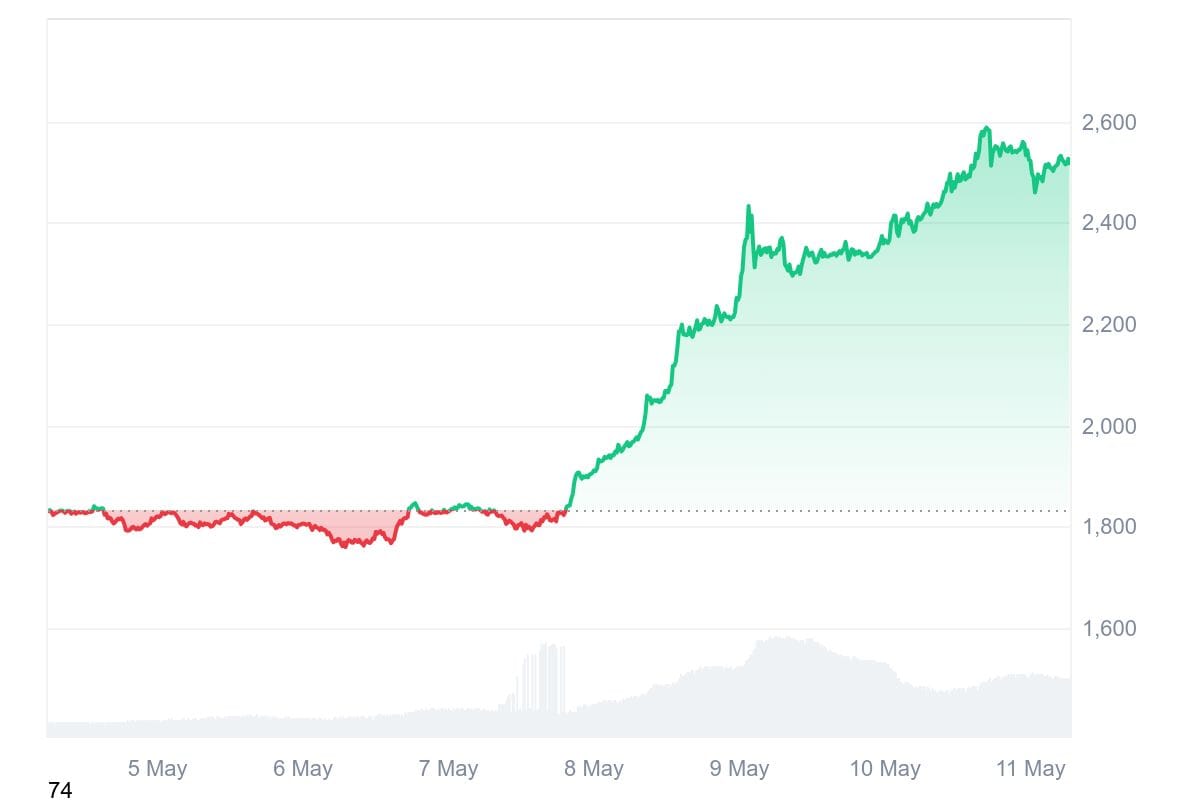Ethereum’s comeback week: Upgrades and new narratives
Ethereum staged a major comeback this week with a 30% price surge and the successful rollout of its Pectra upgrade, which improves wallet UX, staking, and scaling. After months of doubt, the network is regaining momentum — and investor confidence.

The second-largest crypto asset by market cap has just staged its strongest rally in years. In a matter of days, Ethereum’s price broke out of its months-long slump, its core protocol rolled out one of its most important upgrades since the Merge, and its reputation — once bruised by stagnation — suddenly began to recover.
It wasn’t just price action. It was momentum, belief, and execution all arriving at once.

The rally that's rewriting the narrative
Ethereum began May trading in the doldrums. ETH was stuck in the low-$1,800s, down over 50% from its 2024 highs, trailing not just Bitcoin but also newer competitors like Solana and Avalanche.
The crypto crowd talked openly about Ethereum’s decline. There seemed to be a shared sentiment forming that was basically something along the lines of: Ethereum had lost its lead, its users, and maybe even its reason for being.
Then something shifted.
By May 9, ETH had surged past $2,500, logging its biggest weekly gain since 2021 — up nearly 30% in just five days. It wasn’t a random move. It was a cocktail of catalysts that hit all at once:
The Pectra upgrade went live. As we’ll cover below, it was a meaningful, infrastructure-level improvement to Ethereum’s UX and scalability — exactly the kind of forward motion that skeptics said was lacking.
Macro tailwinds kicked in. Bitcoin crossed $100,000 again, and a surprise U.S.–UK trade agreement boosted broader investor sentiment. As crypto markets turned risk-on, ETH short sellers were forced to cover, triggering a short squeeze that amplified the rally.
The rotation back to quality began. Ethereum had lagged behind so long that it became the obvious re-entry play for funds rotating out of overbought assets. With the ETH/BTC ratio at multi-year lows and a clear technical breakout above long-term resistance, the market found a reason to reprice ETH upward.
What’s notable is that this wasn’t just traders flipping charts — it was fundamentals aligning with technicals. Exchange outflows surged, with over 320,000 ETH pulled from trading platforms in late April and early May. Developer chatter revived. ETH-based DeFi saw a 40% increase in total value locked (TVL) month-over-month, pushing past $50 billion again.
Momentum, in short, returned.
But is it sustainable?
Opinions remain split. Some argue Ethereum has now exited its downtrend, with renewed bullishness and a clear path to $3,000 and beyond. Others point out that onchain activity has yet to show significant growth, and that Ethereum’s share of users, developers, and volume is still under pressure from faster, cheaper chains like Solana and Base.
The truth likely lies in the balance. If Ethereum can convert Pectra’s technical progress into real adoption — new apps, better wallets, more stakers — then this rally may mark the start of a longer-term shift. If not, it risks fading into just another blip in the crypto market’s endless churn.
Pectra, the quiet revolution
While headlines focused on price action, Ethereum’s real milestone this week was under the hood.
On May 7, the Pectra hard fork went live — a sprawling protocol upgrade designed not to reinvent Ethereum, but to refine it.
Smart accounts: wallets get a brain
The most user-facing change in Pectra is account abstraction, or what many are calling "smart accounts." Until now, Ethereum wallets were dumb vaults — you could send or receive ETH, but everything required manual, rigid interaction.
Smart accounts flip that script. Now, your wallet can behave like a smart contract. You can:
- Batch transactions: approve and execute in one click.
- Use biometric sign-ins: Face ID instead of private key juggling.
- Let apps pay gas fees: or pay them in stablecoins, not just ETH.
- Recover lost access: set social recovery or backup mechanisms.
- Add spending limits: guardrails for daily use or risky apps.
In short, Pectra makes wallets feel more like apps — and Ethereum, more like something you’d actually want to use.
Staking becomes streamlined
For stakers and validators, Pectra unlocks long-requested improvements. The maximum staking limit has increased from 32 ETH to 2,048 ETH, reducing overhead for institutional participants. Validators can now trigger their own exits, not just rely on third-party operators, and onboarding delays have been addressed.
This means faster, fairer, and more secure staking — for everyone from solo validators to staking-as-a-service platforms. And it’s critical, because Ethereum’s security relies on its validator set being robust, diverse, and responsive.
Scaling for a rollup-centric future
Pectra also boosts Ethereum’s data throughput for Layer 2s. Specifically, it doubles the blob space available for rollups — a kind of ephemeral data storage introduced in last year’s proto-danksharding update.
More blob space means:
- Cheaper L2 transaction costs
- Faster finality for rollup users
- More headroom for growth across chains like Optimism, Arbitrum, and Base
This is key to Ethereum’s future vision: a modular base layer that supports dozens of high-speed, low-cost rollups on top. Pectra doesn’t complete that vision — but it lays more of the groundwork.
The intangible shift: Ethereum, post-stagnation
Perhaps the most meaningful change this week wasn’t technical or financial — it was narrative.
Ethereum went from being portrayed as a bloated, sluggish project in decline to a protocol with momentum, leadership, and a clear path forward. The Ethereum Foundation’s renewed focus on user experience, the successful rollout of a major upgrade, and a week of strong price action all combined to shift the tone.
As one strategist put it: Ethereum “ran out of sellers,” and when it showed real progress, sidelined capital finally moved.
Of course, upgrades don’t guarantee adoption. But Ethereum now has a better UX story, stronger validator incentives, and more scaling headroom than it did a week ago. Combined with renewed attention from developers and institutions, it’s enough to give the ecosystem a second wind.
Whether this is the start of a long-term uptrend or just a bullish pause in a still-challenged cycle remains to be seen. But after months of doubt, Ethereum has reminded the market of its capacity to evolve — and to surprise.
Update on the Open Money Project
I've realized that I could probably keep writing small case studies about how Open Money builds on or improves traditional financial and internet processes. There is so much potential. But I also think it's time to move on, with the goal of keeping the project moving.
This week I'm going to start the next section, which will be about some of the economic underpinnings of Open Money, things like network effects, changes in capital formation, and user (or gas) fees.
I hope you'll consider checking it out.